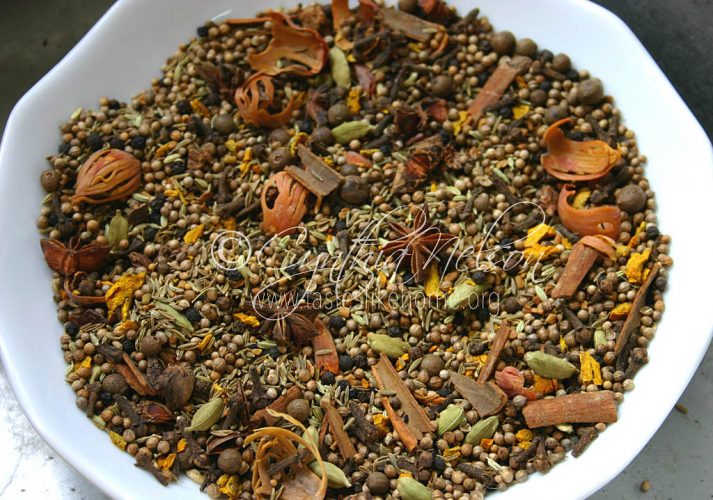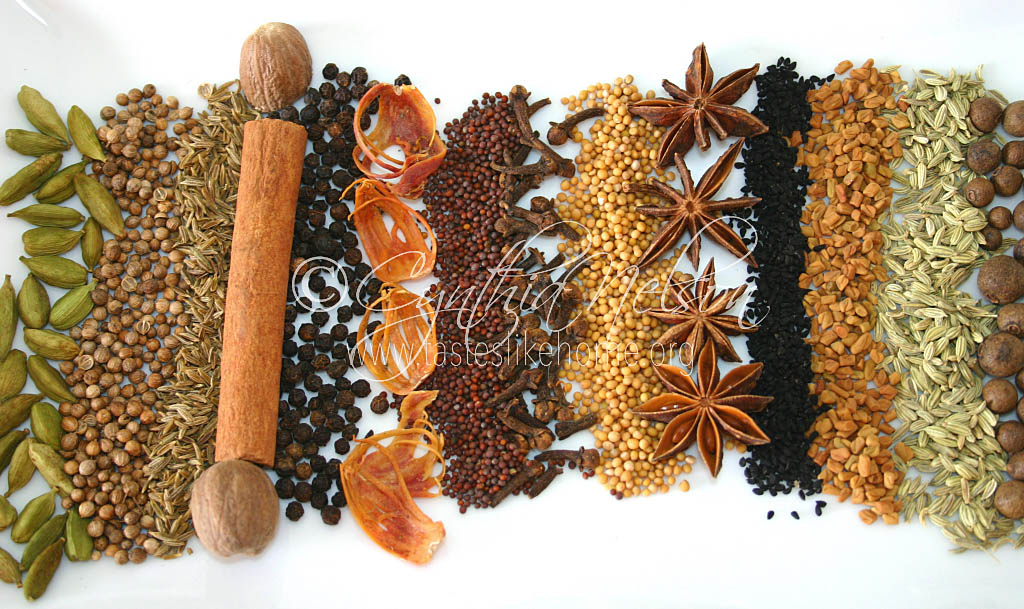
A couple of weeks ago I read a post online where a friend (Guyanese), said that she added cloves to a beef curry she made the other day and was surprised at how well the flavour complemented the curry. Looking at the comments, she was not the only one surprised. There were a few comments suggesting that she also try adding some cinnamon to her curries. And then there were a couple of comments indicating that if you are “in the know” and make your own masala rather than buy, then you won’t be surprised at the inclusion of cloves and cinnamon in the garam masala mix. These latter comments were written in a cryptic manner, an indication of the secrecy with which many households guard their recipes for garam masala, some of which have been passed down from one generation to the next.

Garam masala is a mix of spices, sold whole or ground.
Growing up, my late Auntie Betty was the master blender of spice mixes in the family. The spices would be bought whole in large quantities, sorted, picked through to remove any debris, bits or pieces of spices that were not up to her very high standards. Measuring and weighing by sight and hands, she’d create the family’s signature blend. The spices would then be given a thorough rinse to remove any dust or missed particles, drained well, and then be spread on large homemade rimmed sheet pans and be put in the sun for a couple of days to dry thoroughly. The garam masala would then be sorted into large bottles with airtight covers, a couple of which were given to mommy for our household. When it was time to make a curry, my late mother would remove some of the masala, dry roast it until fragrant, being sure to toss and shake the pan regularly to prevent the spices getting too dark or burning as that would impact the flavour of the curry with bitter notes. Once roasted, the spices were ground fresh using a lorha and sill, the seeds popping under the weight of the heavy brick, the fragrance of the garam masala tickling the nose, sometimes causing one to sneeze. Apart from the spices, aromatics such as garlic, onions and hot peppers were also ground to a paste along with celery. There was enough dried turmeric in the garam masala for flavour and colour. There was no store-bought curry powder in sight; that came along later and whenever it was used in a curry, it was only added to boost the colour of the curry. The women in my family considered curry powder inferior in taste and quality.
Some households have one garam masala mix that they use for their curries while others have different blends, with varying combinations and quantities of spices for different types of curries. There might be one for poultry, which may include duck, another for meats such as lamb/mutton, beef, goat, another one for seafood (mainly fish, shrimp, crab), and yet another masala mix for vegetable curries. I am sure that you have gone into a supermarket or shop and seen masala blends indicating which one is recommended for goat, duck, or lamb/mutton curry.
The use of different garam masala blends is to accentuate and enhance the natural flavours of the main ingredient. Some masalas are for a lighter flavour such as seafood or vegetable curries while others are more robust to complement the richness of certain meats like lamb, goat, or game/wild meats. It’s about the curry, the mood, and the masala, each with its own taste and flavour.
The addition of other ingredients such as onions, garlic, hot peppers, fresh herbs, and tomatoes to a garam masala paste, also contribute to the flavour of a curry.
A basic garam masala mix (whole spices) has cumin (jeera), coriander, cinnamon, cloves, black pepper, cardamom, and nutmeg. However, depending on locale and household, other spices such as dried ginger, mustard seeds (black and yellow), fennel seeds, star anise, fenugreek seeds, dried bay leaves, dried chilies, mace, dried turmeric, and nigella seeds (kalonji/kala jeera) are added in varying quantities, hence creating a signature blend.
I have various garam masala blends that I use. However, I use them without rules. In other words, I might use the masala that is recommended for goat to cook shrimp and the one for chicken to cook vegetables etc. For me it is really all about the masala mood. Here is the other thing, mixing and matching the masala and ingredients reveals new flavours and ways to enjoy certain things. Apart from my personal garam masala blend that’s in my book (My Caribbean Cookbook, Tastes Like Home. Randle 2010), I have put together other blends based on recipes from books and curries from various countries and regions around the world. However, my go-to garam masala is a very special blend that I get from Berbice (in Guyana). One of my cousins buys it freshly ground from a guy that makes a proprietary blend. The spice combo is understandably a trade secret. I love that masala. The only other things I ever add to that garam masala is a fresh paste of garlic, hot peppers, and fresh cilantro/coriander and depending on the curry I am making, fresh ginger and or tomatoes. I am now down to my last one-pound packet that I store in the refrigerator, sometimes in the freezer when I get a new batch. Frankly, it is cause for concern because I am not sure with the Covid environment when I am going to travel to Guyana, so I am treating my Berbice masala like the precious commodity it is.
I’ll leave you with this — if you have never made your own garam masala, try doing so. A wide variety of whole spices are more readily available in Guyana than in some other places. Secondly, if you’re only going to use curry powder for your curry, be sure it is of a superior quality. Remember, it is supposed to be a garam masala blend (hence the name curry powder), so be sure to read the labels and try different brands and types. Let me be frank, a lot of commercial mass-produced curry powders are found lacking because they are bulked up with turmeric powder. A curry is too special a dish to not get the mood and flavour right to suit your taste.
Cynthia
cynthia@tasteslikehome.org






